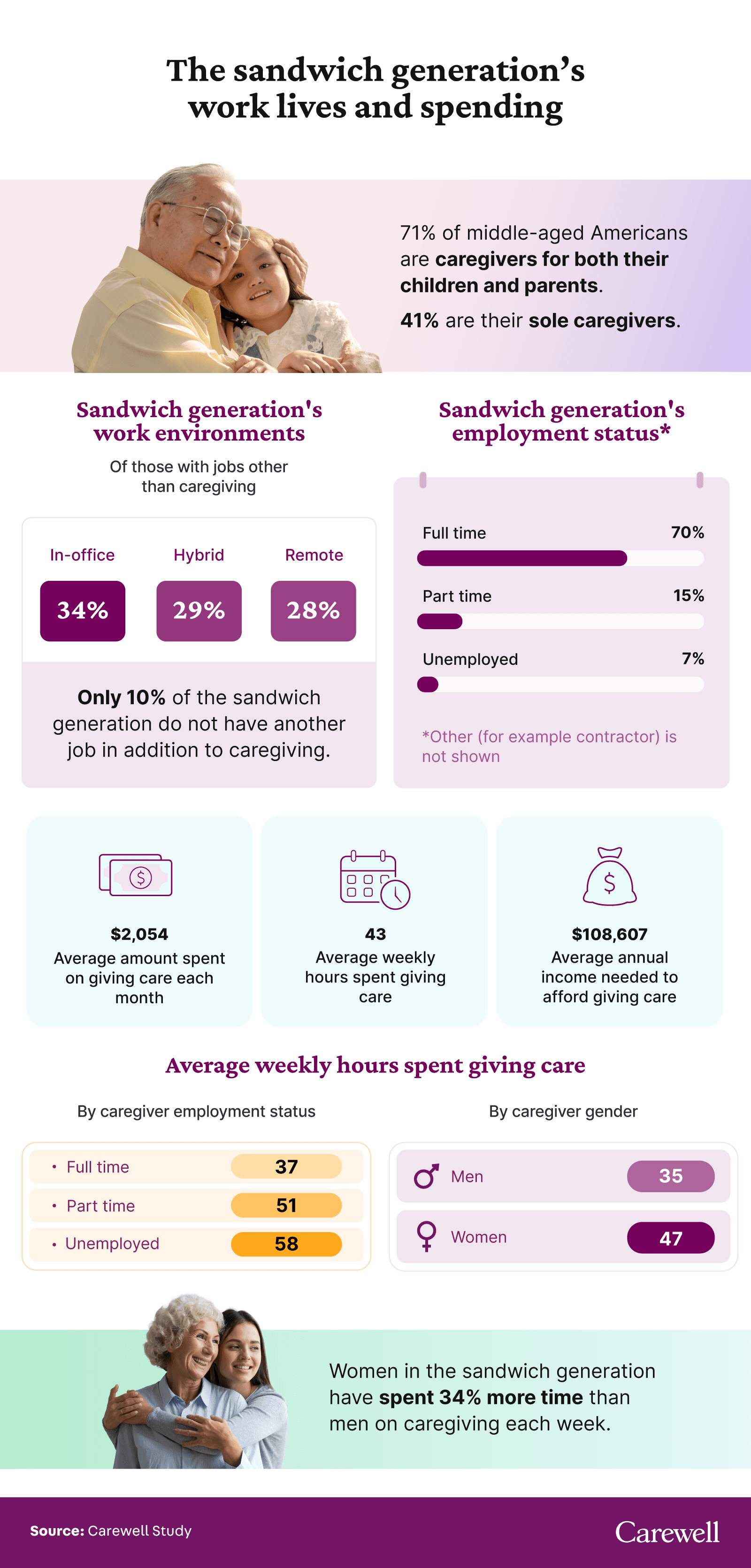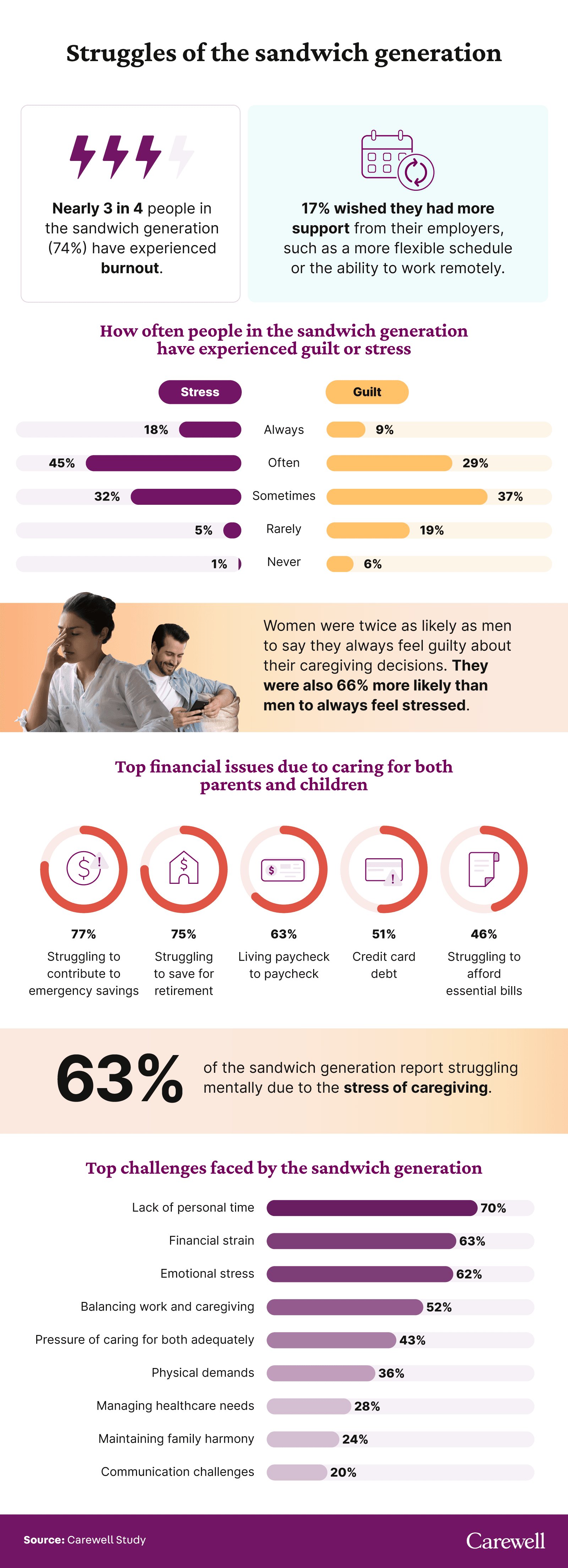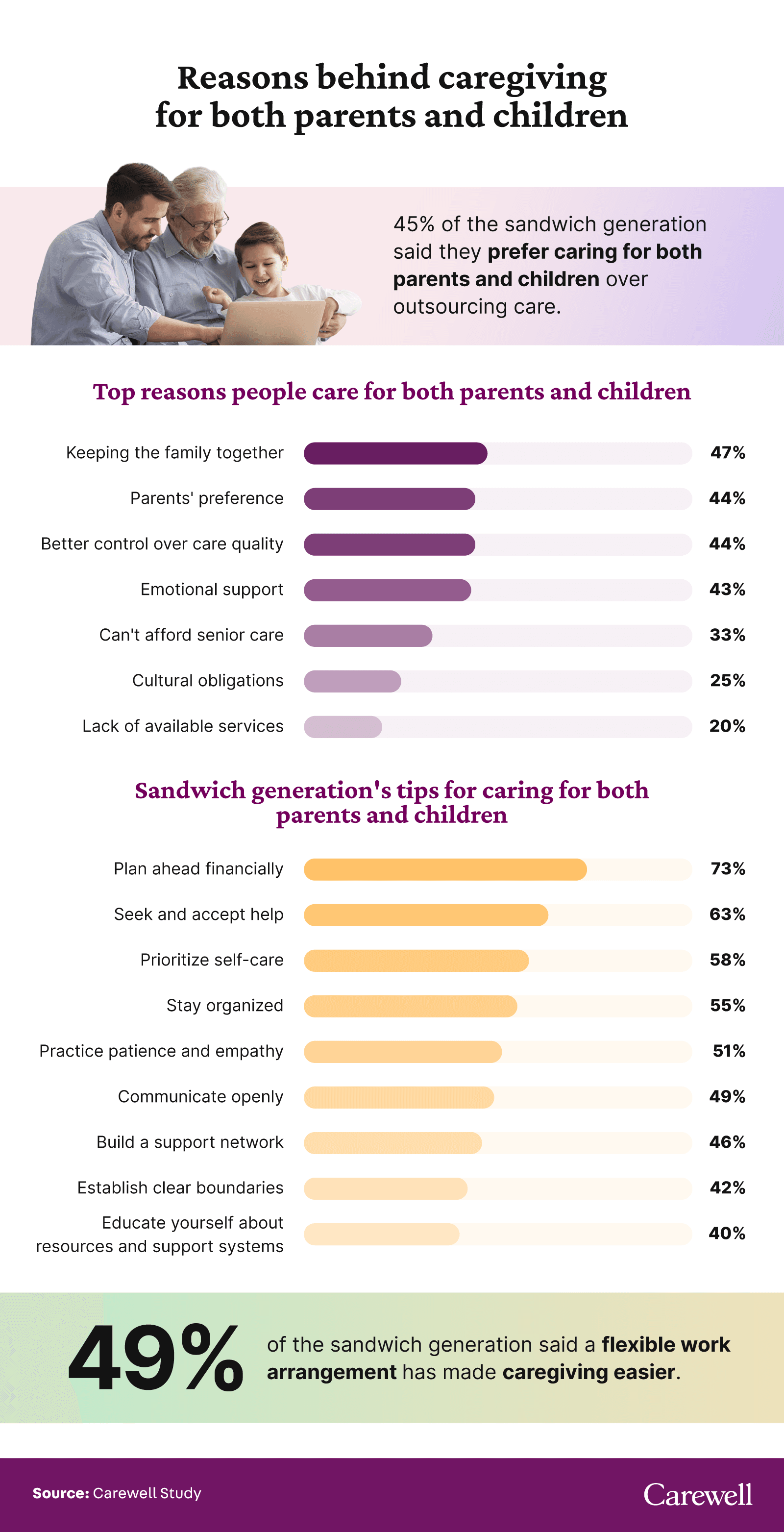Balancing caregiving and a full-time job is a reality for many middle-aged Americans. Often called the “sandwich generation,” these individuals are sandwiched between caring for their children and their aging parents at the same time. To better understand their experiences, we surveyed 1,000 Americans aged 35-60. This article sheds light on their struggles and successes, offering valuable insights and practical tips for caregivers.
Key Takeaways
71% of middle-aged Americans are caregivers for both their children and their parents.
70% balance full-time jobs with caregiving duties, spending an average of 37 hours per week giving care.
Many caregivers (71%) struggle financially due to caregiving responsibilities; 75% find it hard to save for retirement, and 63% live paycheck to paycheck.
Nearly 1 in 5 sandwich generation caregivers (18%) always feel stressed due to their responsibilities.
Dual Responsibilities of Work and Caregiving
Let’s start by seeing how middle-aged Americans of the sandwich generation manage their time and finances while caring for both their children and aging parents.

Many middle-aged Americans (71%) have found themselves in the role of caregiver for both their children and their aging parents. Of them, 70% have to juggle full-time jobs with their caregiving duties, spending an average of 37 hours per week on caregiving tasks in addition to their regular employment. Over a quarter (28%) said they work from home, managing both work and family care simultaneously.
Almost half of the caregivers (47%) said keeping the family together was the main reason for taking on these dual caregiving roles. Financial constraints also played a role, as 33% said they couldn’t afford to outsource senior care, so they had to manage these responsibilities themselves.
Common Caregiving Stressors: You’re Not Alone
Caregiving has many benefits for both the caregiver and the recipient, but it can also come with financial and emotional challenges — especially for sandwich generation caregivers. We asked them about the struggles and emotional tolls they face.

One of the most important things to watch out for when caring for kids, parents, or both is caregiver burnout, which can happen when stress takes a toll. Unfortunately, nearly 1 in 5 (18%) of the sandwich generation reported always feeling stressed due to their caregiving responsibilities. Beyond mental and emotional stress, much of the sandwich generation (71%) reported significant financial stress due to caregiving responsibilities.
A large majority have struggled financially, with 3 in 4 finding it difficult to save for retirement and 63% living paycheck to paycheck. Over half (51%) have accrued credit card debt to cover living expenses and caregiving costs. Financial pressures like these have made it challenging for 77% of respondents to contribute to their emergency savings and for 46% to pay essential bills.
Emotional Rewards of Caregiving and Tips for Success
Despite challenges, the sandwich generation finds great rewards in their caregiving roles. In this section, we examine their reasons for dual caregiving and their advice for those entering this phase of life.

Caregivers shared that the most rewarding part of caregiving was keeping the family together, with 47% expressing this sentiment. Emotional bonding was equally valued by 43%.
Many caregivers (62%) appreciated giving back to their parents, while 52% cherished seeing their parents enjoy time with their grandchildren. Caregiving can also lead to profound personal satisfaction: 42% of the sandwich generation said it gives them a sense of purpose and fulfillment.
We wrapped up our study by asking caregivers to share what they’ve learned from their experiences. Their insights can help guide those who are already dual caregivers or who will be soon. Here’s their advice for caring for both parents and children, along with some resources to get you started.
Practical Tips and Resources
If you’re part of the sandwich generation or preparing for dual caregiving duties, these ideas and resources can help you tackle some common challenges.
1. Plan Ahead Financially
Planning ahead for caregiving expenses was the top tip from 73% of our respondents. Some steps you can take to ease financial stress include:
2. Seek and Accept Help
Seeking and accepting help was suggested by 63% of caregivers. Here are some ways to do this effectively:
Support groups. Join in-person or online caregiver support groups to share experiences and gain emotional support. Websites likeAARP Caregiving offer resources and community connections.
Family and friends. Don’t hesitate to ask family members or friends for help. Whether it’s running errands, preparing meals, or just providing emotional support, involving others can make a big difference.
Professional care services. Consider using respite care services or adult day care programs for extra assistance. Short-term relief from caregiving duties can help ease stress and burnout. Find a respite provider in your local community when needed.
3. Prioritize Self-Care
Taking care of yourself is crucial to avoid burnout. Here’s how you can prioritize self-care:
Schedule regular breaks. Make sure to take time for yourself, even if it’s just a few minutes each day. Practice activities that relax and recharge you, such as reading, walking, or meditation.
Seek professional help. Don’t be afraid to talk to a therapist or counselor. Resources like Psychology Today’s Therapist Directory can help you find a professional in your area or online.
Engage in physical activity. Regular exercise can significantly improve your mood and overall health. Even a short stroll a few days a week can relieve stress and give you a much-needed mental boost.
4. Stay Organized
Staying organized can help you manage your responsibilities more efficiently. Here are some tips:
Use a planner. Keep a planner or use digital apps like Google Calendar to schedule appointments, tasks, and reminders.
Create checklists. Break down tasks into manageable steps and check them off as you complete them. Keep your to-do list on paper or use a mobile app to stay on top of things and limit overwhelm.
Document caregiving information. Maintain a file with important medical information, contact details, and care instructions for both your children and aging parents. This file can be physical or digital.
5. Practice Patience and Empathy
Caregiving can be emotionally taxing, but practicing patience and empathy can make a big difference. Here’s how:
Mindfulness practices. Engaging in mindfulness or meditation practices can help you stay calm and centered. The UCLA Mindful app offers free guided meditation sessions.
Educate yourself. Understanding the conditions and needs of those you care for can help you respond with more empathy. Resources like the Carewell blog and the Family Caregiver Alliance provide valuable information on various caregiving topics.
Communicate openly. Foster open communication about needs, expectations, and feelings with your family members. Regular family meetings can help everyone stay on the same page and address any concerns collaboratively.
These strategies can help caregivers manage the dual responsibilities of work and caregiving, allowing them to maintain their well-being while providing essential support to their loved ones.
Insights and Strategies for the Sandwich Generation
The sandwich generation has many responsibilities, including balancing work, caregiving, and financial pressures. By planning financially, seeking flexible work arrangements, and accepting help, they can tackle these challenges with resilience and dedication. Understanding their experiences can inspire better support systems and resources, ensuring caregivers get the help they need to thrive.
Methodology
We surveyed 1,002 Americans aged 35-60 to explore the challenges of being in the “sandwich generation.” Of these, 71% were caregivers for both their children and parents, aka the sandwich generation.
About Carewell
Carewell is committed to helping caregivers thrive. We understand the joys and struggles of caregiving — that’s why we’re dedicated to providing not only top-quality products but also the empathy, support, and guidance you need to feel confident and cared for in your role as a caregiver.
Fair Use Statement
Spread the word! Share this data non-commercially, and please link back to show your appreciation.






